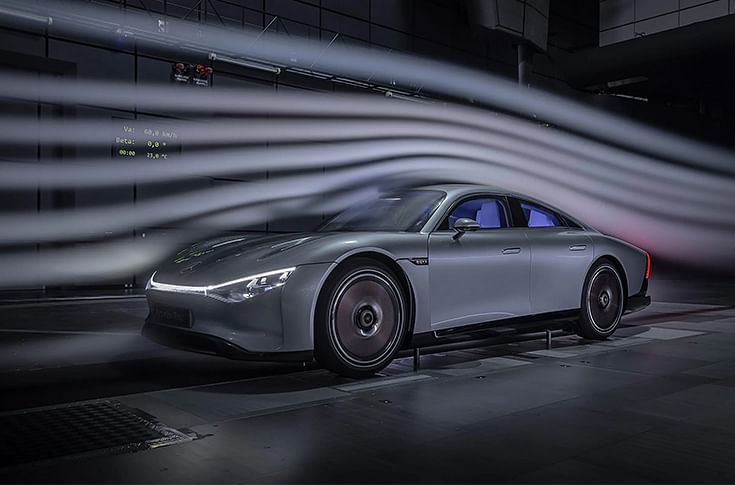ICE is nice: New Merc EV design to conform with time-tested DNA
Focus on efficiency has led to radical, aerodynamic shapes for Merc EVs, but convergence with traditional ICE cars is imminent when range is less of an issue.
Car brands have adopted a distinctly different design approach for their EV range in an attempt to stand out from their ICE counterparts and look futuristic. This not only involves EV-specific design details such as blanked-off grilles, distinctive light signatures and flush fitting door handles, but also the overall shape and form factor.
Mercedes-Benz, for instance, has two completely different design philosophies for its ICE and electric vehicles, the key differentiation being brought about by aerodynamics that’s critical for range. Gorden Wagener, Chief Design Officer at Mercedes-Benz, speaking to Autocar India shares some of the design highlights in the EVs.
Mercedes’ EQ design optimised for aero efficiency

“Aero is a big factor on electric vehicles, much more than on combustion cars but all our cars are aerodynamic champions and they look great.” said Wagener.
This is evident in the brand’s EQE and EQS ranges that have a distinctive low-slung, curvaceous, and cab-forward look, that's very different from the brand’s traditional three-box sedans.
Even the SUVs in the EQ range are far from being boxy, tall and upright, almost naturally having a coupe-ish look to them.
“Apart from the overall shape, aero is also about the details,” explains Wagener. “Most of the aerodynamic measures are actually not visible. Take, for example, how the wind hits the front wheels, how it hits the rear wheels, and most importantly, how it behaves with the edges at the rear — all this needs to be balanced,” he elaborated.
EQ models could revert to traditional forms in future
But while Mercedes has purposefully formulated its EQ design language around aero and efficiency, what’s interesting is that the radical approach hasn’t quite clicked with the discerning luxury car buyer. Take the EQS sedan for instance – Mercedes sold about 19,200 units worldwide in 2022, while the similarly priced, ICE S-Class sold over 90,000 units. The EQS, therefore, only makes for just over 20 percent of the S-Class’ total sales.
Wagener acknowledged the same saying, “I think customers perceive the combustion engine more like a chrono watch, whereas they perceive an electric car more like a smart watch. Right now, the S-Class segment is still dominated by ICE.”
In contrast, BMW’s i7, which looks near identical to its ICE counterpart, makes up about 40 percent of the 7 Series’ total sales. BMW’s EVs, in fact, haven’t strayed too far from traditional forms, and while their design itself may be contentious, there isn’t so much of a divide between ICE and EVs. Even Audi has stuck to a familiar design language with its e-tron range of EVs.
For Mercedes, a cab-forward design with a swooping nose and wheels pushed to the edges to maximise the wheelbase for the battery may be critical for range and efficiency now, but Wagener hinted that in the future, the brand could go back to more traditional design cues.
“In the long run, when range is not so much of a concern, and also, if there’s a point when people can charge EVs more like they fuel their combustion cars in something like 15 minutes, then, that I think will allow us to create more traditional designs and even boxy, iconic SUVs like the G.”
Iconic designs like the G to be retained even with EVs
Speaking of which, Wagener insists that icons such as the G-Class will always retain its boxy and upright silhouette, even if that means sacrificing some range. “The G is an icon for us and in our DNA. A ‘G’ is a ‘G’, and you must not change it much. You can slightly modernise it, and as we’ve done with every new generation, we’ve carefully evolved it.” He refers to the all-electric EQG as the “most un-aerodynamic car you can imagine,” but one where they are willing to “sacrifice some range for boldness.” In fact, the G’s design language will also be carried forward on to the upcoming ‘little G,’ which too was confirmed at the IAA motor show in September.
RELATED ARTICLES
Renault India's Quiet Fixer
As the head of Renault India, Francisco Hidalgo Marques faces his biggest challenge yet.
Tesla’s Test
Unlike in other markets, Tesla has taken a long-game approach in India, focusing on creating the infrastructure first.
‘India’s E20 Strategy Is the Template Europe Now Needs’
Mahle CEO Arnd Franz believes India’s flex-fuel shift is proving more resilient and market-aligned than the EU’s all-ele...






 05 Jan 2024
05 Jan 2024
 7677 Views
7677 Views





 Ketan Thakkar
Ketan Thakkar




